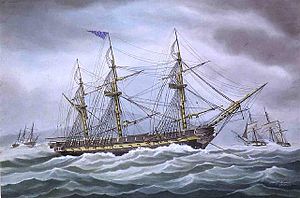 President rides out a storm at anchor.
| |
| History | |
|---|---|
| Name | USS President |
| Namesake | President of the United States |
| Ordered | 27 March 1794[1] |
| Builder | Initially Forman Cheesman; later Christian Bergh |
| Cost | $220,910[2] |
| Laid down | 1798[3] |
| Launched | 10 April 1800[4] |
| Maiden voyage | 5 August 1800 |
| Captured | 15 January 1815 |
| General characteristics | |
| Class and type | 44-gun Frigate |
| Tonnage | 1,576 tons [5] |
| Length | 175 ft (53 m) between perpendiculars, at Keel:146 feet, 7 3/4 inches[6] |
| Beam | 44 ft 4 in (13.51 m) or 43 feet, 8 inches[7] |
| Depth of hold | 13 ft 11 in (4.24 m)[8] |
| Decks | Orlop, Berth, Gun, Spar |
| Propulsion | Sail |
| Complement | 400[9] |
| Armament |
|
| Name | HMS President |
| Acquired | 15 January 1815 |
| Fate | Broken up, 1818[a] |
| General characteristics [10] | |
| Class and type |
|
| Tons burthen | 1533 7⁄94 (bm) |
| Length |
|
| Beam | 44 ft 4 in (13.5 m) |
| Depth of hold | 13 ft 11 in (4.2 m) |
| Armament |
|
USS President was a wooden-hulled, three-masted heavy frigate of the United States Navy, nominally rated at 44 guns; she was launched in April 1800 from a shipyard in New York City. President was one of the original six frigates whose construction the Naval Act of 1794 had authorized, and she was the last to be completed. The name "President" was among ten names submitted to President George Washington by Secretary of War Timothy Pickering in March of 1795 for the frigates that were to be constructed.[11][12] Joshua Humphreys designed these frigates to be the young Navy's capital ships, and so President and her sisters were larger and more heavily armed and built than standard frigates of the period. Forman Cheeseman, and later Christian Bergh were in charge of her construction. Her first duties with the newly formed United States Navy were to provide protection for American merchant shipping during the Quasi War with France and to engage in a punitive expedition against the Barbary pirates in the First Barbary War.
On 16 May 1811, President was at the center of the Little Belt affair; her crew mistakenly identified HMS Little Belt as HMS Guerriere, which had impressed an American seaman. The ships exchanged cannon fire for several minutes. Subsequent U.S. and Royal Navy investigations placed responsibility for the attack on each other without a resolution. The incident contributed to tensions between the U.S. and Great Britain that led to the War of 1812.
During the war, President made several extended cruises, patrolling as far away as the English Channel and Norway; she captured the armed schooner HMS Highflyer and numerous merchant ships. In January 1815, after having been blockaded in New York for a year by the Royal Navy, President attempted to run the blockade, and was chased by a blockading squadron. During the chase, she was engaged and crippled by the frigate HMS Endymion off the coast of the city. The British squadron captured President soon after, and the Royal Navy took her into service as HMS President until she was broken up in 1818. President's design was copied and used to build the next HMS President in 1829.
- ^ Cite error: The named reference
NHFQWwas invoked but never defined (see the help page). - ^ Roosevelt (1883), p. 48.
- ^ Cite error: The named reference
Toll107was invoked but never defined (see the help page). - ^ Toll (2006), p. 138.
- ^ a b Cite error: The named reference
DANFSwas invoked but never defined (see the help page). - ^ Naval Documents related to the Quasi-War Between the United States and France (PDF). Vol. VII Part 1 of 4: Naval Operations December 1800-December 1801, December 1800-March 1801. U.S. Government Printing Office. p. 370. Retrieved 1 October 2024 – via Ibiblio.
- ^ Naval Documents related to the Quasi-War Between the United States and France (PDF). Vol. VII Part 1 of 4: Naval Operations December 1800-December 1801, December 1800-March 1801. U.S. Government Printing Office. p. 370. Retrieved 1 October 2024 – via Ibiblio.
- ^ Naval Documents related to the Quasi-War Between the United States and France (PDF). Vol. VII Part 1 of 4: Naval Operations December 1800-December 1801, December 1800-March 1801. U.S. Government Printing Office. p. 370. Retrieved 1 October 2024 – via Ibiblio.
- ^ Naval Documents related to the Quasi-War Between the United States and France (PDF). Vol. VII Part 1 of 4: Naval Operations December 1800-December 1801, December 1800-March 1801. U.S. Government Printing Office. p. 370. Retrieved 1 October 2024 – via Ibiblio.
- ^ Winfield (2008), p. 124.
- ^ Pickering, Timothy (14 March 1795). Letter to George Washington. Founders Online, National Archives. Retrieved 25 September 2019
- ^ Brodine, Charles E.; Crawford, Michael J.; Hughes, Christine F. (2007). Ironsides! the Ship, the Men and the Wars of the USS Constitution. Fireship Press. p. 8. ISBN 9781934757147.
Cite error: There are <ref group=lower-alpha> tags or {{efn}} templates on this page, but the references will not show without a {{reflist|group=lower-alpha}} template or {{notelist}} template (see the help page).